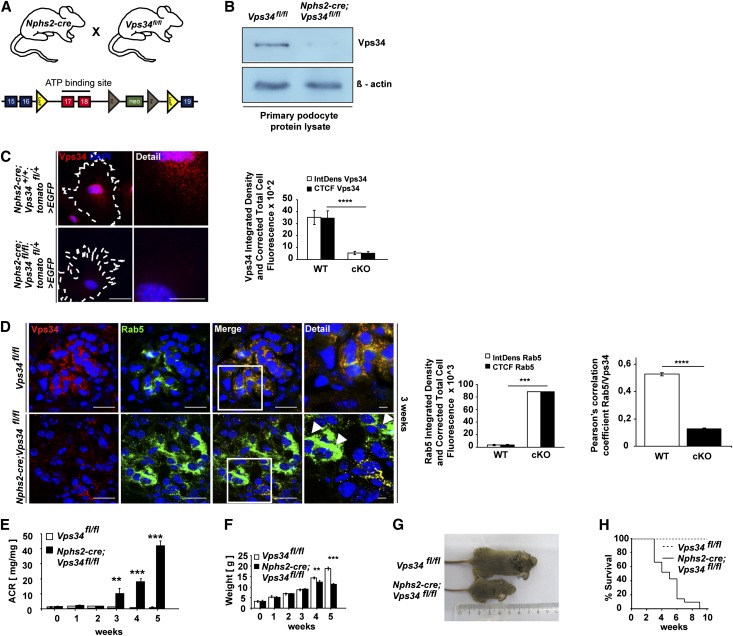Figure 1.
Conditional Vps34 depletion in mouse podocytes induces massive proteinuria and early lethality. (A) Mice expressing cre recombinase under control of the podocyte-specific Nphs2 promoter were crossed to Vps34fl/fl mice to generate podocyte-specific Vps34 knockout mice. (B) Western blot analysis of freshly isolated podocyte protein lysates confirmed significant reduction of Vps34 in podocytes of Nphs2-cre;Vps34fl/fl conditional knockout mice. β-actin was used as loading control. (C) Quantification of immunofluorescence microscopy confirms efficient knockout of Vps34 in primary isolated podocytes. Scale bars, 20 µm; 5 µm in detail. (D) Colabeling immunofluorescence staining with Rab5 and Vps34 on kidney sections of conditionally Vps34-deficient mice and wild-type controls. Increased Rab5 expression in Vps34-deficient podocytes at 3 weeks of age (white arrowheads). ****P<0.0001. (E) Nphs2-cre;Vps34fl/fl mice develop early proteinuria. Albumin/creatinine ratios are significantly increased from 3 weeks of age in Vps34fl/fl;Nphs2-cre mice (n=10 per group; ***P<0.001, **P<0.01; two-tailed t test, mean values ± SEM are shown). (F) Weight curve of Vps34fl/fl control and Nphs2-cre;Vps34fl/fl conditional knockout mice; significant differences in weight can be observed by week 4 (n=10 per group; ***P<0.001, **P<0.01, two-tailed t test, mean values ± SEM are shown). (G) Nphs2-cre;Vps34fl/fl mice exhibit significant growth impairment at 5 weeks of age. (H) Kaplan–Meyer survival curve of Vps34fl/fl control and Nphs2-cre;Vps34fl/fl mice (n=35 per group). All Nphs2-cre;Vps34fl/fl mice died within 9–10 weeks after birth; the first death was observed at 3 weeks of age.

